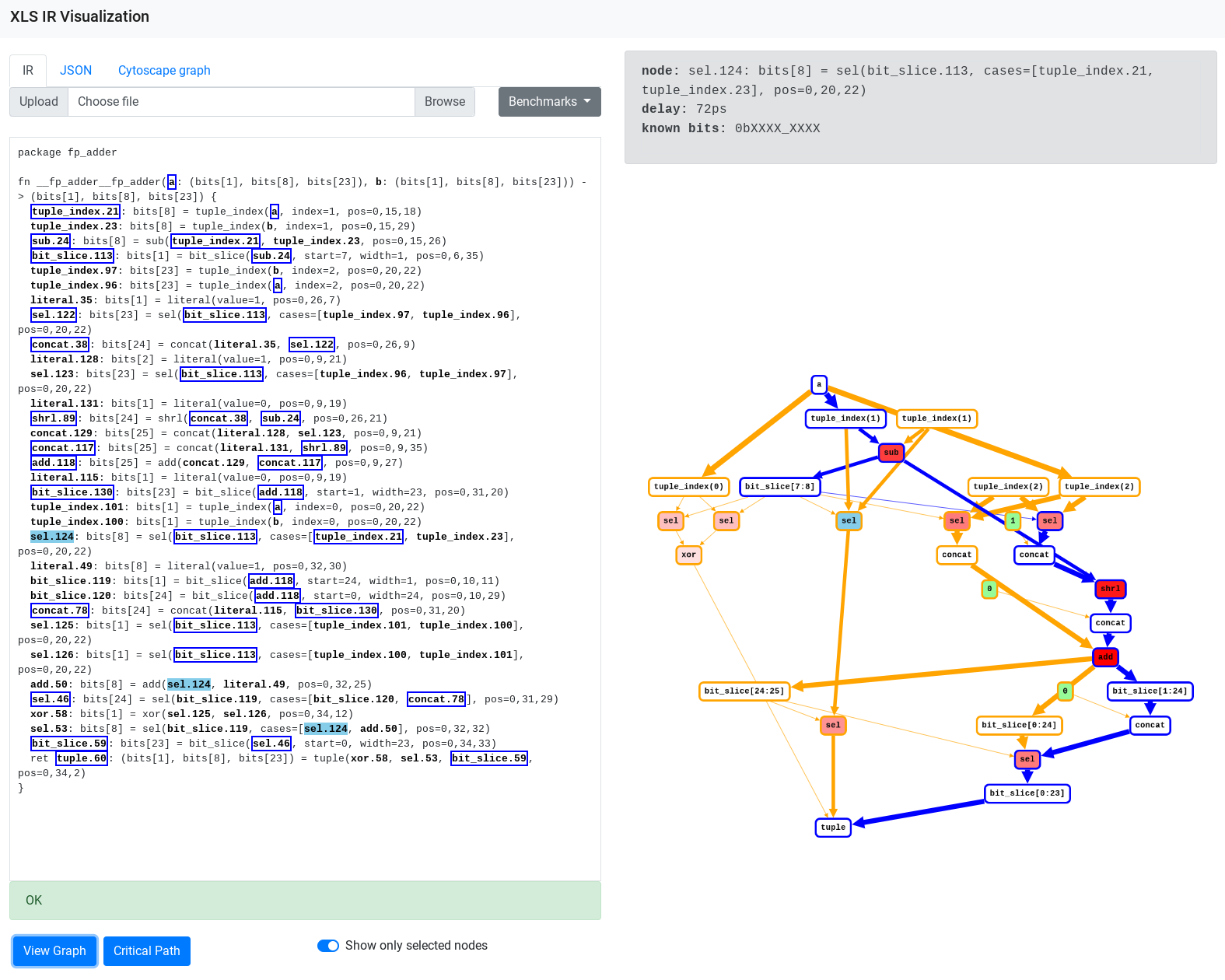IR Visualization
The XLS IR visualization web app presents the IR in text and graphical form side-by-side and enables interactive exploration of the IR.
Running the web app
To build and launch the IR visualization web app run:
bazel run -c opt //xls/visualization/ir_viz:app -- --delay_model=unit
Then visit http://localhost:5000 in a browser.
Screenshot
The screenshot below shows a zoomed-in portion of the IR graph for the
fp_adder benchmark. The highlighted path in blue is the timing critical path
the through the graph.

Usage
Text IR
The left hand side of the UI shows the IR in text form in an editable text box. The IR may be entered or loaded in several ways:
- Upload from a file on the local file system via the Upload button.
- Enter directly by typing in the text box or cut and pasting.
- Load a pre-compiled benchmark via the Benchmarks button. The IR is from the benchmark after optimizations.
The text IR is parsed as you type. The result of the parse (OK or an error) appears in an alert at the bottom of the text box. On successful parsing all identifiers in the IR will be shown in bold.
IR graph
The right-hand side of the UI shows the IR in graphical form. Clicking on the View Graph button renders the text IR on the left hand side as a graph. The View Graph button is enabled only if the IR is parsed successfully. The graph view may be manipulated as follows:
- Zoom The mouse scroll wheel zooms the view of the IR graph.
- Pan Clicking and holding the left mouse button down in the graph panel (while not on a graph element) and moving the mouse pans the graph.
- Moving nodes Nodes in the graph are moved by clicking and holding on the node and moving the mouse.
- Focusing on nodes Clicking on a node in the graph while holding down the control key scrolls the respective definition of the node in the text IR into view in the text box. Similarly, control clicking on an identifier in the text IR zooms and centers the graph view on the respective node.
Node colors
Every node in the graph is assigned a color on a spectrum from white (#FFFFFF)
to red (#FF0000) depending on the modeled latency of the operation. The nodes
with the longest latency in the graph are assigned red. Nodes with zero latency
are assigned white.
Hovering on IR elements
Hovering on nodes and edges in the graph highlights the corresponding element in the text IR and vice versa. In the text IR, the definition and all uses of the IR value are highlighted when a node is highlighted. When a graph edge is highlighted, the definition and corresponding use are highlighted in the text IR.
Information about a highlighted node (identifier in text IR) is displayed in a box above the IR graph. This information includes:
- The definition of the IR value in text form.
- Estimate of the delay in picoseconds of the corresponding operation. The delay estimation methodology is described here.
- Any known bits of the value as determined by the query engine (https://github.com/google/xls/tree/main/xls/passes/query_engine.h).
Selecting nodes
Nodes in the graph may be in a selected or deselected state. Clicking on a node in the graph or identifier in the text IR toggles the selection state. A selected node (identifier in IR text) is shown with a blue border. Nodes and edges which are neighbors of selected nodes (the selection frontier) are shown in orange. Clicking on an empty area of the graph deselects all nodes.
Showing only selected nodes
The toggle Show only selected nodes controls whether to show the entire graph or only the selected node and those elements in the selection frontier. Showing only selected nodes can be used to display only a subgraph of interest. For large graphs which are slow to render in their entirety, this mechanism can be used to interactively explore parts of the graph.
When showing only selected nodes, the graph maybe be expanded by selecting additional nodes to add to the graph. The graph is re-rendered to include the newly selected node. Similarly, nodes may be removed from the graph by deselecting nodes.
Selecting the critical path
The button Critical Path selects exactly those nodes which are on the critical path as determined by XLS's timing model. This may be used with the Show only selected nodes toggle to show a graph containing only critical path elements and neighbors. In the screenshot above, the selected critical path is shown in blue.